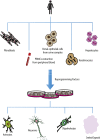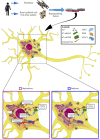Deepening the understanding of CNVs on chromosome 15q11-13 by using hiPSCs: An overview
- PMID: 36684422
- PMCID: PMC9852989
- DOI: 10.3389/fcell.2022.1107881
Deepening the understanding of CNVs on chromosome 15q11-13 by using hiPSCs: An overview
Erratum in
-
Corrigendum: Deepening the understanding of CNVs on chromosome 15q11-13 by using hiPSCs: An overview.Front Cell Dev Biol. 2023 Feb 1;11:1141334. doi: 10.3389/fcell.2023.1141334. eCollection 2023. Front Cell Dev Biol. 2023. PMID: 36819100 Free PMC article.
Abstract
The human α7 neuronal nicotinic acetylcholine receptor gene (CHRNA7) is widely expressed in the central and peripheral nervous systems. This receptor is implicated in both brain development and adult neurogenesis thanks to its ability to mediate acetylcholine stimulus (Ach). Copy number variations (CNVs) of CHRNA7 gene have been identified in humans and are genetically linked to cognitive impairments associated with multiple disorders, including schizophrenia, bipolar disorder, epilepsy, Alzheimer's disease, and others. Currently, α7 receptor analysis has been commonly performed in animal models due to the impossibility of direct investigation of the living human brain. But the use of model systems has shown that there are very large differences between humans and mice when researchers must study the CNVs and, in particular, the CNV of chromosome 15q13.3 where the CHRNA7 gene is present. In fact, human beings present genomic alterations as well as the presence of genes of recent origin that are not present in other model systems as well as they show a very heterogeneous symptomatology that is associated with both their genetic background and the environment where they live. To date, the induced pluripotent stem cells, obtained from patients carrying CNV in CHRNA7 gene, are a good in vitro model for studying the association of the α7 receptor to human diseases. In this review, we will outline the current state of hiPSCs technology applications in neurological diseases caused by CNVs in CHRNA7 gene. Furthermore, we will discuss some weaknesses that emerge from the overall analysis of the published articles.
Keywords: 15q11-13; CHRNA7; CNV; copy number variation; neurodevelopmental disorders; neuropsychiatric disorders; nicotinic acetylcholine receptor.
Copyright © 2023 Giovenale, Ruotolo, Soriano, Turco, Rotundo, Casamassa, D’Anzi, Vescovi and Rosati.
Conflict of interest statement
The authors declare that the research was conducted in the absence of any commercial or financial relationships that could be construed as a potential conflict of interest.
Figures




Similar articles
-
Corrigendum: Deepening the understanding of CNVs on chromosome 15q11-13 by using hiPSCs: An overview.Front Cell Dev Biol. 2023 Feb 1;11:1141334. doi: 10.3389/fcell.2023.1141334. eCollection 2023. Front Cell Dev Biol. 2023. PMID: 36819100 Free PMC article.
-
Functional Consequences of CHRNA7 Copy-Number Alterations in Induced Pluripotent Stem Cells and Neural Progenitor Cells.Am J Hum Genet. 2017 Dec 7;101(6):874-887. doi: 10.1016/j.ajhg.2017.09.024. Epub 2017 Nov 9. Am J Hum Genet. 2017. PMID: 29129316 Free PMC article.
-
Altered neuronal physiology, development, and function associated with a common chromosome 15 duplication involving CHRNA7.BMC Biol. 2021 Jul 28;19(1):147. doi: 10.1186/s12915-021-01080-7. BMC Biol. 2021. PMID: 34320968 Free PMC article.
-
The human clinical phenotypes of altered CHRNA7 copy number.Biochem Pharmacol. 2015 Oct 15;97(4):352-362. doi: 10.1016/j.bcp.2015.06.012. Epub 2015 Jun 18. Biochem Pharmacol. 2015. PMID: 26095975 Free PMC article. Review.
-
The human CHRNA7 and CHRFAM7A genes: A review of the genetics, regulation, and function.Neuropharmacology. 2015 Sep;96(Pt B):274-88. doi: 10.1016/j.neuropharm.2015.02.006. Epub 2015 Feb 19. Neuropharmacology. 2015. PMID: 25701707 Free PMC article. Review.
References
Publication types
LinkOut - more resources
Full Text Sources

